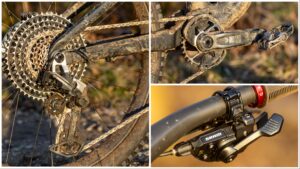Kinesis has switched to titanium for a feature-rich hardtail that covers two wheel standards in three sizes
Kinesis Maxlight Sync Ti review
Kinesis is well known for its keenly priced aluminium hardtails, but the UK firm has recently launched a new high-end frame made from titanium. The finish is first-rate; it’s packed with innovation and, most interestingly, the new Sync uses size-specific wheels: 29in on the medium and large, and 650b on the size small.
Kinesis already has a 29er hardtail in its range, so it’s no surprise to see the Sync get big wheels on the medium and large frames. The reason for the downsize on the size small is about packaging — Kinesis says it wanted the small bike to benefit from the increased rollover of bigger wheels while still feeling manoeuvrable and responsive. It also didn’t want to compromise on the stand-over clearance, or, to a lesser extent, the look of the bike, because small 29er frames can sometimes look out of proportion.
When designing the Sync, Kinesis was keen to incorporate modern trail bike geometry, which meant making it longer, lower and slacker and working the reach around a short stem and wide handlebar. The head angle on our medium test bike wasn’t that progressive — we tested some £600 hardtails last month that were slacker than this — but the frame didn’t feel cramped and at 5ft 11in I was able to ride a medium (rather than a large) quite comfortably thanks to the extra length in the top tube.
The material’s inherent resilience means that titanium bikes are generally pretty comfortable and, while the Sync is more forgiving than the firm’s aluminium FF29, it’s still pretty stiff compared to most titanium bikes. For Kinesis, the Sync is more about propulsion than comfort, as you can see from the oversized PF30 bottom bracket shell and bolt-thru back end. That said, Kinesis fitted a carbon seatpost to our test bike to help dampen trail chatter.
The intricate investment-cast dropouts feature a post disc mount and a direct mount rear mech hanger. The latter is a Shimano-inspired design and is basically a machined arm that replaces the B2 link on the Shadow Plus rear derailleur. Fitting the link adds stiffness to improve shifting performance, and saves 17g in weight.
The Sync is a clean-looking, understated hardtail and the ride is equally unfussy. It’s agile, responsive and felt right at home on tight singletrack and fast, flowing trails. You have to work a bit on rougher trails by feeding the bike in and out of the holes or hopping over them, but the directness does make the Sync a rapid climber.
>>> Click here to find out more about geometry with our handy guide
Verdict
At £1,500, the Sync frame is relatively affordable for titanium, with a level of detail and innovation you usually only see on frames costing twice as much. The small 650b option will definitely be of interest to shorter riders.
















